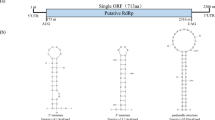Abstract
Members of the fungal genus Hypoxylon of the family Xylariaceae are known to produce secondary metabolites with significant chemical diversity. There are more than 200 species in the genus, including the filamentous fungus Hypoxylon fendleri. To the best of our knowledge, there have been no reports of mycoviruses in H. fendleri. In this study, a novel mycovirus, designated “Hypoxylon fendleri mitovirus 1” (HfMV1), was isolated from this fungus. The genome of HfMV1 is 2850 nt in length with a G + C content of 36% and contains a large open reading frame (ORF) encoding an RNA-dependent RNA polymerase (RdRp). BLASTp analysis revealed that the RdRp domain of HfMV1 had 28.30–50.90% sequence identity to those of members of the genus Duamitovirus and had the highest identity (50.90%) to Fusarium graminearum mitovirus 2-2 (FgMV2-2). Phylogenetic analysis further indicated that HfMV1 is a member of the genus Duamitovirus of the family Mitoviridae. This is the first report of a mycovirus in H. fendleri.


Similar content being viewed by others
Data availability
The data supporting this study's findings are available in the GenBank database.
References
Bruenn JA, Warner BE, Yerramsetty P (2015) Widespread mitovirus sequences in plant genomes. PeerJ 3:e876
Cai X, Tian F, Teng L, Liu H, Tong Y, Le S, Zhang T (2021) Cultivation of a lytic double-stranded RNA bacteriophage infecting Microvirgula aerodenitrificans reveals a mutualistic parasitic lifestyle. J Virol 95:e0039921
Dickschat JS, Wang T, Stadler M (2018) Volatiles from the xylarialean fungus Hypoxylon invadens. Beilstein J Org Chem 14:734–746
Dodds TJMAJA (1979) Isolation and analysis of double-stranded RNA from virus-infected plant and fungal tissue. Phytopathology 69:854–858
Fonseca P, Ferreira F, da Silva F, Oliveira LS, Marques JT, Goes-Neto A, Aguiar E, Gruber A (2020) Characterization of a novel mitovirus of the sand fly Lutzomyia longipalpis using genomic and virus-host interaction signatures. Viruses 13:9
Hillman BI, Cai G (2013) The family narnaviridae: simplest of RNA viruses. Adv Virus Res 86:149–176
Intaraudom C, Bunbamrung N, Dramae A, Boonyuen N, Kongsaeree P, Srichomthong K, Supothina S, Pittayakhajonwut P (2017) Terphenyl derivatives and drimane—phathalide/isoindolinones from Hypoxylon fendleri BCC32408. Phytochemistry 139:8–17
Intaraudom C, Punyain W, Bunbamrung N, Dramae A, Boonruangprapa T, Pittayakhajonwut P (2019) Antimicrobial drimane—phthalide derivatives from Hypoxylon fendleri BCC32408. Fitoterapia 138:104353
Kamauchi H, Suzuki M, Takao K, Sugita Y (2022) A benzaldehyde derivative obtained from Hypoxylon truncatum NBRC 32353 treated with hygromycin B. J Antibiot 75:1–8
Nibert ML, Vong M, Fugate KK, Debat HJ (2018) Evidence for contemporary plant mitoviruses. Virology 518:14–24
Shahi S, Eusebio-Cope A, Kondo H, Hillman BI, Suzuki N (2019) Investigation of host range of and host defense against a mitochondrially replicating mitovirus. J Virol 93:6
Tamura K, Stecher G, Kumar S (2021) MEGA11: molecular evolutionary genetics analysis version 11. Mol Biol Evol 38:3022–3027
Teng L, Li X, Cai X, Yang S, Liu H, Zhang T (2022) The complete genome sequence of a novel mycovirus in the plant-pathogenic fungus Exobasidium gracile. Arch Virol 167:1343–1347
Yu YH, Chen JY, Yi WT, Li MM, Li X, Zeng HT, Yuan T (2022) Secondary metabolites of endophyte Hypoxylon sp. HD-2014 from Uncaria rhynchophylla. China J Chin Mater Med 47:3816–3821
Zhou P, Zheng M, Li XN, Wei M, Zhang M, Li Q, Zang Y, Sun W, Wang J, Zhu H, Chen C, Zhang Y (2021) Hypoxylonoids A-G: Isopimarane diterpene glycosides from Xylaria hypoxylon. Phytochemistry 182:112613
Acknowledgements
This work was supported by the Guizhou Provincial Science and Technology Projects (Grant numbers ZK [2021]081, [2018]5779-53).
Author information
Authors and Affiliations
Corresponding authors
Ethics declarations
Conflict of interest
The authors declare that they have no conflict of interest.
Ethical approval
This study did not include experiments with human participants or animals performed by any of the authors.
Additional information
Handling Editor: Ioly Kotta-Loizou .
Publisher's Note
Springer Nature remains neutral with regard to jurisdictional claims in published maps and institutional affiliations.
Supplementary Information
Below is the link to the electronic supplementary material.
Rights and permissions
Springer Nature or its licensor (e.g. a society or other partner) holds exclusive rights to this article under a publishing agreement with the author(s) or other rightsholder(s); author self-archiving of the accepted manuscript version of this article is solely governed by the terms of such publishing agreement and applicable law.
About this article
Cite this article
Li, X., Ding, F., Zeng, L. et al. A novel mitovirus isolated from the filamentous fungus Hypoxylon fendleri. Arch Virol 168, 198 (2023). https://doi.org/10.1007/s00705-023-05811-9
Received:
Accepted:
Published:
DOI: https://doi.org/10.1007/s00705-023-05811-9




